With a project timeline, you can adapt to the developing project needs and track progress without any mess.
Project management is required for everything related to a project, from ensuring every task is assigned to timely project completion within the planned budget. As a project manager, you might be familiar with stakeholder questions, such as when we will start and finish.
Without this information, you may be subject to miscommunication, missed deadlines, and stretched budgets. You can avoid these situations by crafting a project timeline in project management software. The tool can help you derive significant benefits even if your project has multiple stakeholders, interdependent tasks, and a defined budget.
In this guide, we'll explain a project timeline and help you learn how to create one.
What is a project timeline?
A project timeline helps teams determine when a project can start and when it needs to be finished. The project timeline also shows all important due dates and milestones from the beginning to the end of a project.
A project timeline is similar to the project schedule, but they're not the same thing. You can think of a timeline as the meat of your project schedule. A project schedule is a more comprehensive document that includes detailed information about the project. A project timeline is a specific, focused schedule that meticulously outlines important dates and deadlines and plots them on a timeline chart.
In other words, the project timeline is a piece of the project schedule, and the project schedule is a piece of the project plan.
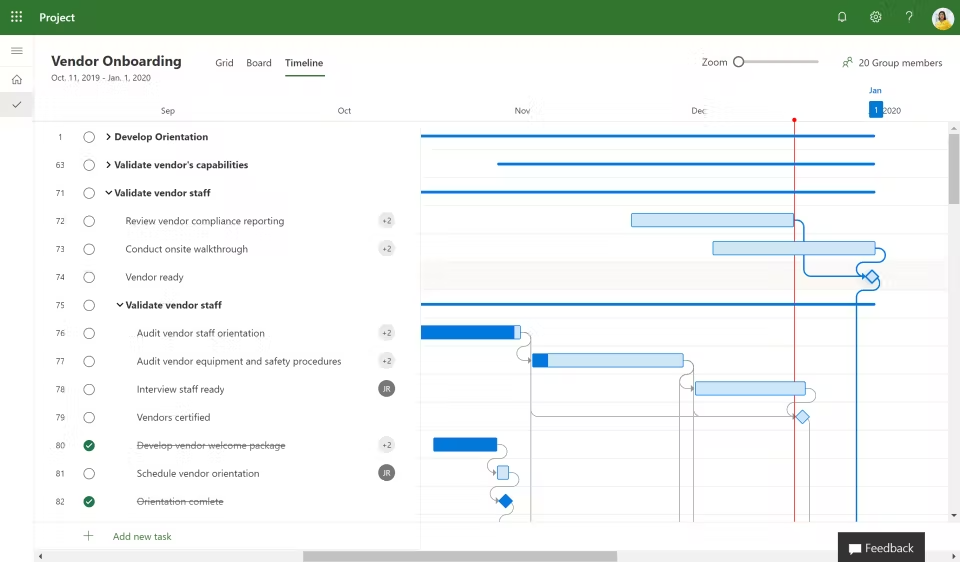
An example of a project timeline in Microsoft Project project management software (Source)
What are the benefits of a project timeline?
A project timeline is especially useful because it shows when the final deliverable is due and when each task along the way should be completed to meet the target deadline.
More accurate timeline estimations can help teams plan better and save time and resources from project overruns and scope creep. This can happen when a project's goals and expectations expand beyond the agreed plan after starting the project. Additionally, accurate timeline estimates can help improve client relationships.
Here are other reasons to use project management software to create timelines.
Easy dependency tracking: The more complicated your projects get, the more dependencies they have. You might be able to track these dependencies manually for simple projects, but you'll want software to keep track of multiple dependencies and avoid missing any important tasks.
Better stakeholder communication: While you could email a spreadsheet timeline to stakeholders every time it's updated, it can become unmanageable on projects requiring multiple stakeholders and updates. The software provides a central location where everyone can stay updated with the latest timeline.
Automation: If you make a timeline manually and fall behind on one step, you'll have to manually adjust every subsequent step and milestone to reflect these changes. Project management software’s automation capabilities can do this without your intervention, saving you hours of time over the life of a project.
What are the different types of project timelines?
There are multiple types of project timelines and you can choose one according to the complexity of your project and preferences.
Basic project timeline
A basic project timeline includes a timeline with tasks and milestones laid out horizontally from left to right across vertical columns of dates.
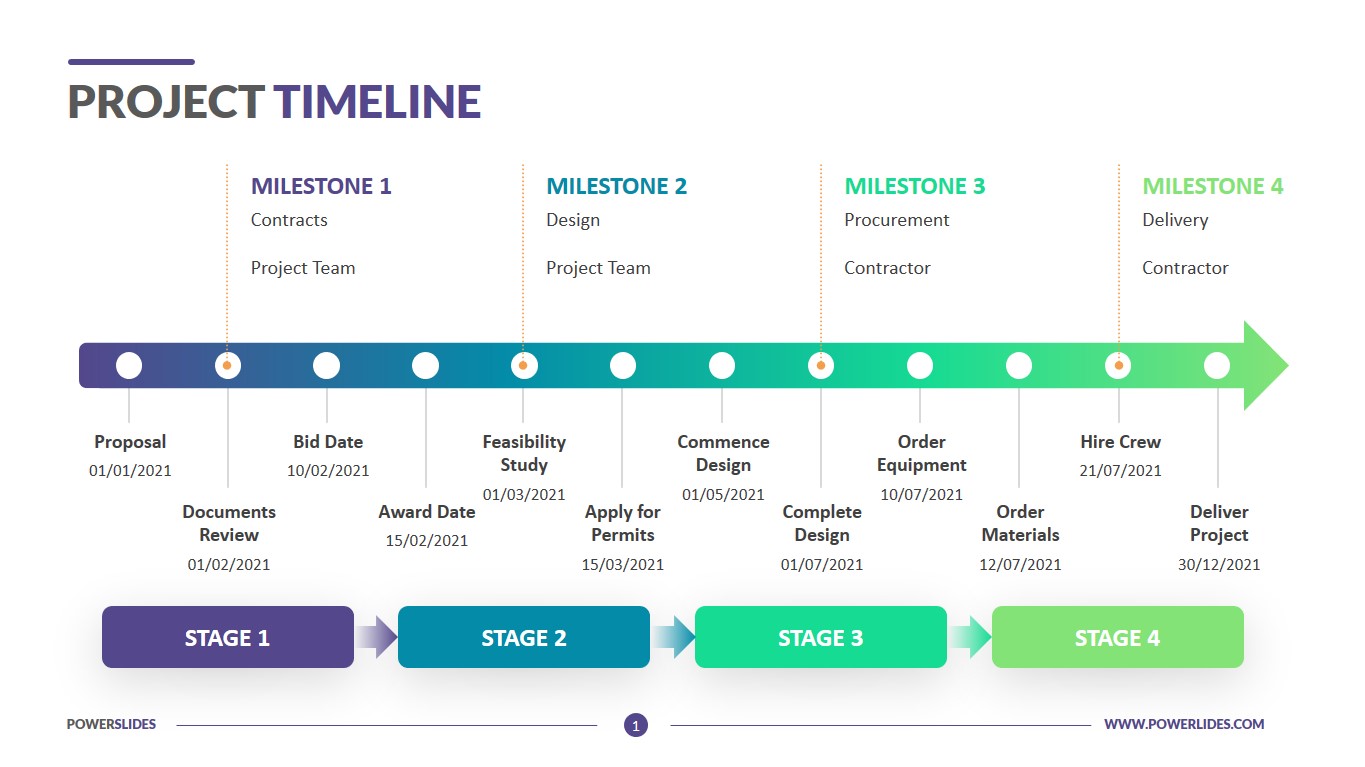
An example of a basic project timeline template from PowerSlides[1]
These timelines can be visualized in a few different ways. Let's explore two common variations on the project timeline: the Gantt chart and the PERT chart.
Gantt chart
As a variation of the basic timeline, a Gantt chart includes interdependencies in the timeline by adding the dimension of overlapping tasks. In the example below, you can see that the "Outreach" and "Implementation" tasks can be worked on simultaneously, but "Implementation testing" cannot begin until "Implementation" is complete.
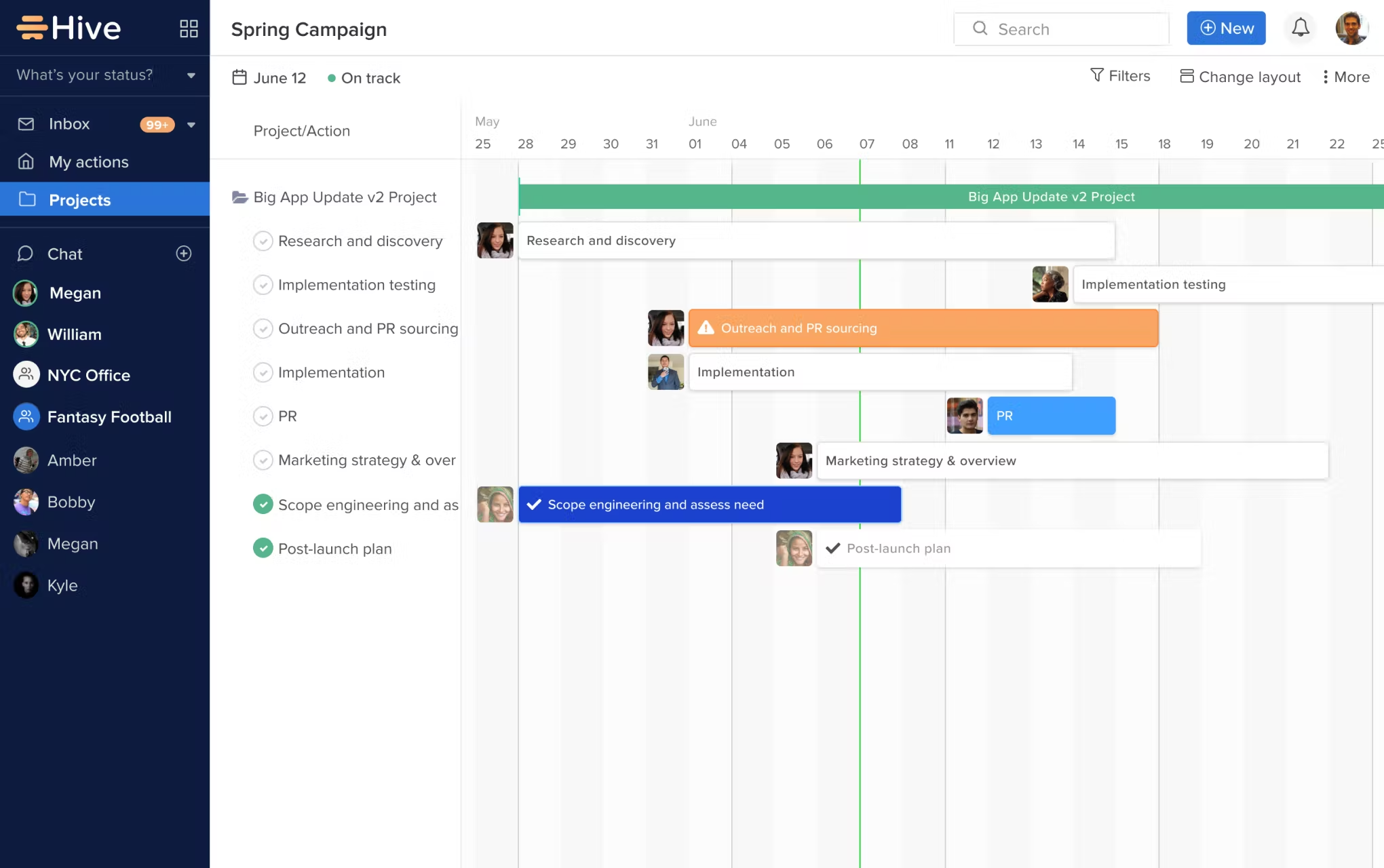
An example of a Gantt chart showing overlapping and interdependent tasks in Hive project management software (Source)
PERT chart
A PERT (Program Evaluation and Review Technique) chart looks much different than a Gantt chart, using more of a network diagram to show interdependencies and total project duration. PERT charts are created in tandem with the critical path method, which uses an algorithm to determine the minimum time needed to complete a project based on dependencies between required tasks.
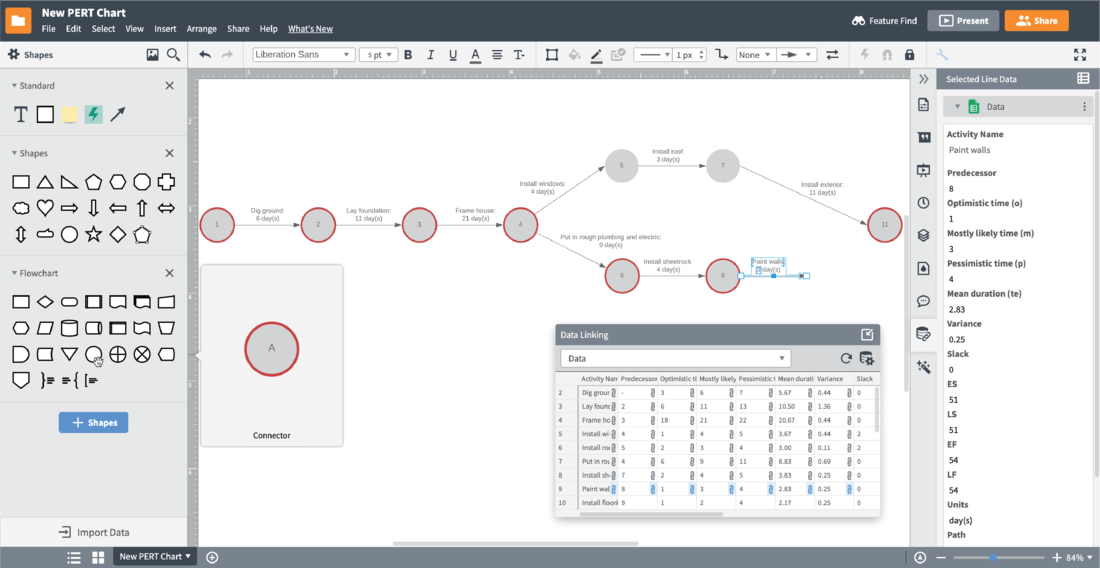
An example of a PERT chart in Lucidchart diagram software[2]
What are the key elements of a well-structured project timeline?
In its most basic form, a project timeline should include a start date, a series of tasks, and an end date. More advanced elements include milestones and dependencies. Here are more details:
Start date and end date: The calendar dates when your project begins and the final deliverable is due. These dates are typically determined during project planning.
Tasks: Everything that must be done to complete the project. These tasks are usually determined through the work breakdown structure during project planning.
Milestones: Key dates during the project. Another way to think of project milestones is as chapters within the project. Milestones can include deliverable due dates, project phases, midpoint progress checks, and start and end dates.
Dependencies: The relationships between varied tasks dictate the order of task completion. For example, Task A must be completed before Task B can begin. Such dependencies are determined during project planning and indicated by overlapping bars on a Gantt chart and through lines connecting tasks on a PERT chart.
How to build a comprehensive project timeline
You can create a basic project timeline using pen and paper or a spreadsheet. However, project management software is the easiest and most effective way to create a project timeline.
All you need to create a project timeline is a task list, a starting point, and a final deadline. Once you have this information, it's a matter of plotting the required tasks along the timeline.
If you want to practice writing a project timeline manually, just follow these steps:
Reference your project plan and work breakdown structure to gather all necessary tasks for completing your project.
Identify interdependencies between these tasks to determine which tasks need to be completed before others can begin.
Set a realistic project start and finish date and indicate them on a horizontal chart.
Plot out all the interdependent tasks along this chart, allotting a realistic amount of time for each task, and adjust as necessary as your project progresses.
Project management software can do all this work for you, including updating the timeline. Say one deliverable deadline needs to be pushed back, the software will automatically push back the final deadline as well.
Best practices to manage and adjust your project timeline
Based on the findings of Capterra's 2023 Project Stakeholder Engagement Survey*, several aspects of project governance are thought to impact project timelines negatively. You can use these results to better manage and adjust your project timeline.
Here are some best practices to consider:
Roles and responsibilities
The top reason project timelines are negatively impacted, according to 58% of project managers, is a lack of clarity in roles and responsibilities.* To avoid this, you can
Use a RACI (Responsible, Accountable, Consulted, Informed) matrix [1] to define team roles and responsibilities clearly.
Regularly communicate and revisit roles and responsibilities to ensure clarity and accountability among all involved.
Engagement and communication
Fifty-two percent of project managers feel that unclear expectations about engagement and communication affect project timelines.* You can avoid this by
Establishing a solid communication plan with clear channels to keep everyone updated.
Encouraging open communication to address issues and promptly prevent project delays.
Project scopes
A lack of properly managing project scopes is the third reason for poor timelines based on the experiences of 50% of project managers.* SMBs can tackle this challenge by
Planning project objectives, deliverables, and limitations thoroughly and carefully.
Engaging stakeholders early, implementing a change process, and regularly reviewing project scope.
Control processes
Nearly half (47%) of project managers indicated timeline issues were related to weak project management control processes.* To avoid such situations, you can
Establish a clear framework, milestones, and progress tracking to keep projects within budget and on schedule.
Regularly evaluate and revise control processes based on feedback and best practices.
Risks and issues
Poor risk and issue management impacted the project timelines of 46% of project managers.* Avoid this by
Developing a proactive risk management plan and regularly assessing project risks.
Promptly addressing emerging issues, fostering transparency, and adjusting plans as needed.
Governance
Lastly, 22% of project managers found that project timelines were affected by disengaged governance committees.* You can sail through this challenge by
Actively involving stakeholders to build strong relationships and garner support.
Communicating the importance of their role in decision-making to prevent unnecessary delays.
When should you use software to create project timelines?
Project management software is recommended to create your project timelines in virtually every scenario other than the simplest projects. However, if you want to create a timeline independently, we've got you covered.
You can use a template to create your own project planning timeline for any type of project with a start and end date and a list of required tasks. Just follow the steps in the 'How to build a comprehensive project timeline' section above and then adjust the timeline as necessary during the project.
Project timelines are a standard feature in virtually all project management software. So, to find the best project timeline software, you can start your search with our Capterra Shortlist for Project Management Software. This list features 25 top options based on popularity and ratings from thousands of verified reviews.
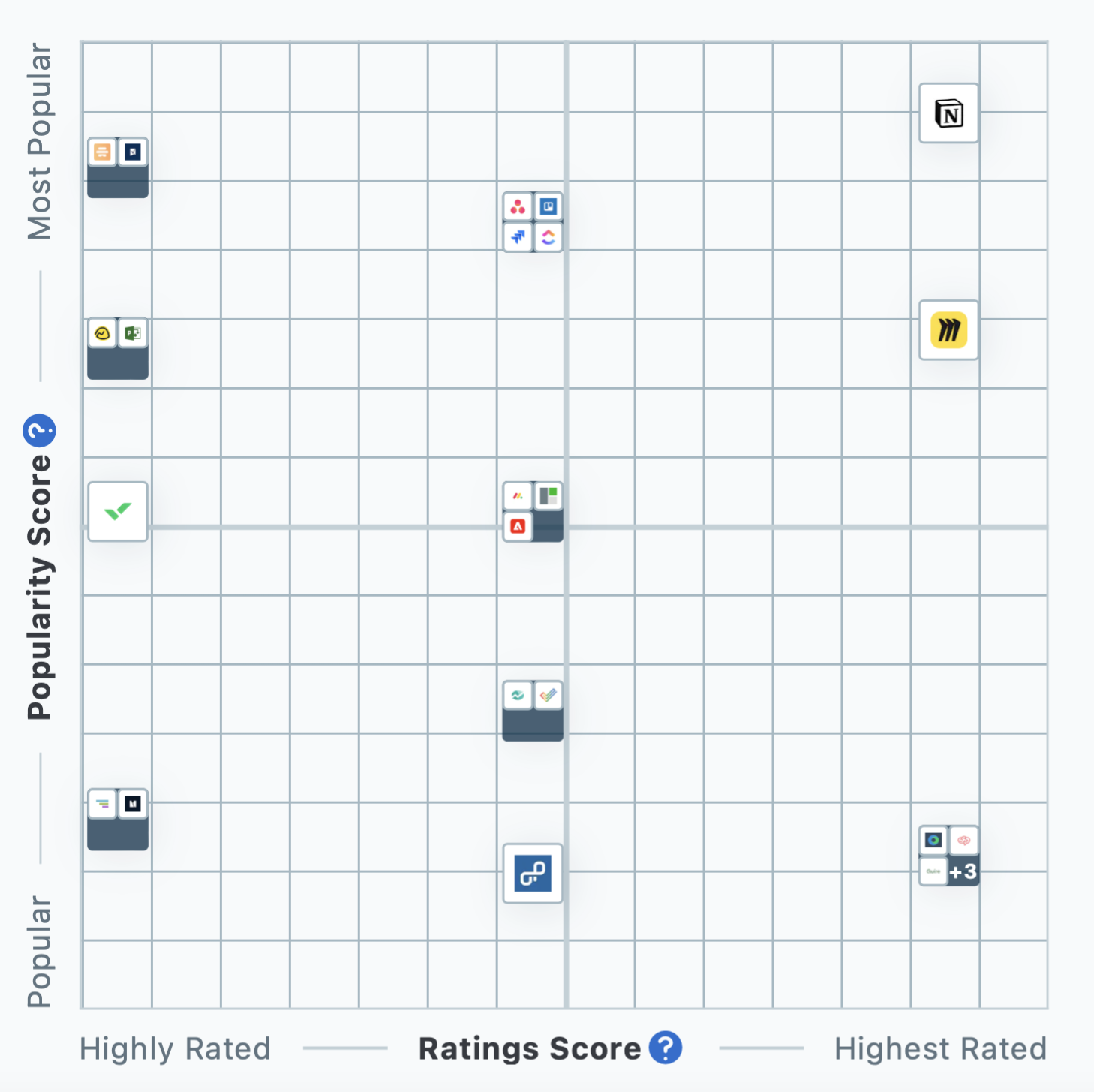
2024 Capterra Shortlist for project management software (Source)
Check out the following articles on our blog if you want to read more about project management software:

